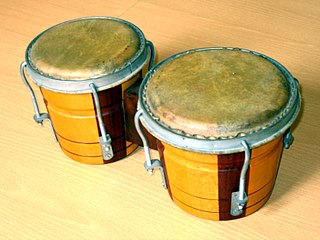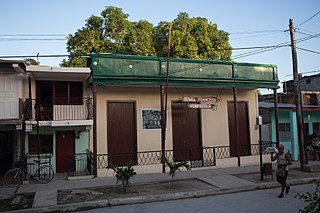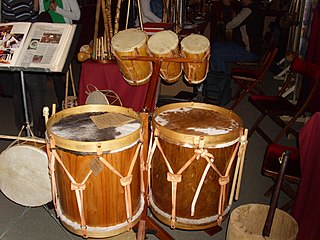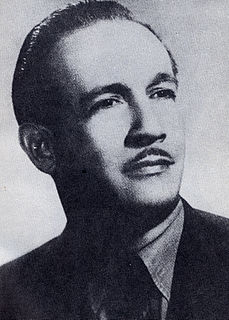Mambo is a genre of Cuban dance music pioneered by the charanga Arcaño y sus Maravillas in the late 1930s and later popularized in the big band style by Pérez Prado. It originated as a syncopated form of the danzón, known as danzón-mambo, with a final, improvised section, which incorporated the guajeos typical of son cubano. These guajeos became the essence of the genre when it was played by big bands, which did not perform the traditional sections of the danzón and instead leaned towards swing and jazz. By the late 1940s and early 1950s, mambo had become a "dance craze" in the United States as its associated dance took over the East Coast thanks to Pérez Prado, Tito Puente, Tito Rodríguez and others. In the mid-1950s, a slower ballroom style, also derived from the danzón, cha-cha-cha, replaced mambo as the most popular dance genre in North America. Nonetheless, mambo continued to enjoy some degree of popularity into the 1960s and new derivative styles appeared, such as dengue; by the 1970s it had been largely incorporated into salsa.
The music of Cuba, including its instruments, performance and dance, comprises a large set of unique traditions influenced mostly by west African and European music. Due to the syncretic nature of most of its genres, Cuban music is often considered one of the richest and most influential regional musics of the world. For instance, the son cubano merges an adapted Spanish guitar (tres), melody, harmony, and lyrical traditions with Afro-Cuban percussion and rhythms. Almost nothing remains of the original native traditions, since the native population was exterminated in the 16th century.
The tres is a guitar-like three-course chordophone of Cuban origin. The most widespread variety of the instrument is the original Cuban tres with six strings. Its sound has become a defining characteristic of the Cuban son and it is commonly played in a variety of Afro-Cuban genres. In the 1930s the instrument was adapted into the Puerto Rican tres, which has nine strings and a body similar to that of the cuatro.

Bongos are an Afro-Cuban percussion instrument consisting of a pair of small open bottomed drums of different sizes. In Spanish the larger drum is called the hembra (female) and the smaller the macho (male). Together with the conga or tumbadora, and to a lesser extent the batá drum, bongos are the most widespread Cuban hand drums, being commonly played in genres such as son cubano, salsa and Afro-Cuban jazz. A bongo drummer is known as a bongosero.

The conga, also known as tumbadora, is a tall, narrow, single-headed drum from Cuba. Congas are staved like barrels and classified into three types: quinto, tres dos or tres golpes (middle), and tumba or salidor (lowest). Congas were originally used in Afro-Cuban music genres such as conga and rumba, where each drummer would play a single drum. Following numerous innovations in conga drumming and construction during the mid-20th century, as well as its internationalization, it became increasingly common for drummers to play two or three drums. Congas have become a popular instrument in many forms of Latin music such as son, descarga, Afro-Cuban jazz, salsa, songo, merengue and Latin rock.

Jesús Valdés Rodríguez, better known as Chucho Valdés, is a Cuban pianist, bandleader, composer and arranger whose career spans over 50 years. An original member of the Orquesta Cubana de Música Moderna, in 1973 he founded the group Irakere, one of Cuba's best-known Latin jazz bands. Both his father, Bebo Valdés, and his son, Chuchito, are pianists as well. He has won six Grammy Awards and three Latin Grammy Awards.
The term conga refers to the music groups within Cuban comparsas and the music they play. Comparsas are large ensembles of musicians, singers and dancers with a specific costume and choreography which perform in the street carnivals of Santiago de Cuba and Havana.

Tumba francesa is a secular Afro-Cuban genre of dance, song, and drumming that emerged in Oriente, Cuba. It was introduced by slaves from Haiti—then a French colony known as Saint-Domingue—whose owners resettled in Cuba's eastern regions following the slave rebellion during the 1790s. The genre flourished in the late 19th century with the establishment of sociedades de tumba francesa, of which only three survive.
Irakere is a Cuban band founded by pianist Chucho Valdés in 1973. They won the Grammy Award for Best Latin Recording in 1980 with their album Irakere. Irakere was a seminal musical laboratory, where historic innovations in both Afro-Cuban jazz and Cuban popular dance music were created. The group used a wide array of percussion instruments like batá, abakuá and arará drums, chequerés, erikundis, maracas, claves, cencerros, bongó, tumbadoras (congas), and güiro.
Cuban folk music includes a variety of traditional folk music of Cuba, and has been influenced by the Spanish and the African culture as well as the remaining indigenous population of the Caribbean.
Rumba is a secular genre of Cuban music involving dance, percussion, and song. It originated in the northern regions of Cuba, mainly in urban Havana and Matanzas, during the late 19th century. It is based on African music and dance traditions, namely Abakuá and yuka, as well as the Spanish-based coros de clave. According to Argeliers León, rumba is one of the major "genre complexes" of Cuban music, and the term rumba complex is now commonly used by musicologists. This complex encompasses the three traditional forms of rumba, as well as their contemporary derivatives and other minor styles.

The bombo criollo, or simply bombo, is a family of Latin American drums derived from the European bass drum and native Latin American drum traditions. These drums are of smaller dimensions than the orchestral bass drum, and their frame can be made of wood or steel. They can be held vertically or diagonally on the body or a stand. The specific make of the instrument depends on the regional tradition. In Argentina, the bombo criollo is called bombo legüero. In Cuba, it is known as bombo de comparsa due to its use in comparsas. In other countries, the term tambora is commonly used.

Eliseo Grenet Sánchez was a Cuban pianist and a leading composer/arranger of the day. He composed music for stage shows and films, and some famous Cuban dance music. Eliseo was one of three musical brothers, all composers, the others being Emilio and Ernesto (1908–1981). Emilio went on composing even after having a leg bitten off by a shark in 1930; Ernesto was a drummer who became leader of the Tropicana's orchestra.

The cajones de rumba are wooden boxes used as rhythmic percussion instruments in some styles of Cuban rumba. There are different types of cajones, namely the cajón tumbadora, the cajón bajo and the cajita, all of which are hand-struck.
Tahona, alternatively spelled tajona due to its pronunciation or taona, is a secular style of Afro-Cuban music developed in the 19th century in Santiago de Cuba after the arrival of Haitian slaves following the Haitian Revolution. It is named after the ensembles and the drums played by them. It is considered one of the oldest styles within the rumba complex, and its performance became rare by the 20th century.
Music of African heritage in Cuba derives from the musical traditions of the many ethnic groups from different parts of West Africa that were brought to Cuba as slaves between the 16th and 19th centuries. Members of some of these groups formed their own ethnic associations or cabildos, in which cultural traditions were conserved, including musical ones.
The first African drums were heard in Cuba, since the 16th century, only during the celebration of certain feasts, such as the Día de Reyes and Carnestolendas or Carnival, because their use was restricted to some mutual aid societies, called "Cabildos de nación", where the slaves and their descendants were allowed to gather and practice their cultural and religious traditions.
Coros de clave were popular choral groups that emerged at the end of the 19th century in Havana and other Cuban cities. Their style was influenced by the orfeones which grew popular in northern Spain in the mid-19th century, and their popularization in the island was linked to the emancipation of African slaves in 1886. The common instrumentation of the coros featured a viola, claves, guitar, harp and jug bass.












